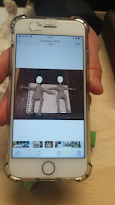At this point, I sought advice from Virpi Kettu about needle felting my puppet. She suggested there needed to be a balance with the tightness of the wool and that I should use finger protectors due to the barbs on the felting needles. This was good advice and helped improve my technique further.
In the above image, Virpi helps me with the head of the armature to model thin aluminium wire to give it a round 3D shape. We used a fast-drying glue to attach the wire mesh head to the main body.
These images of her puppets, served as inspiration and development for my puppet work. At this stage it was useful to see the development stages, finished well-crafted pieces and the potential of the process I was exploring.
Virpi took the photos above of how I developed my puppet by finishing the wrapping and starting the needle felting stage. I used part of an Argos felting kit for making cats I bought in semester 2. This was a starter kit from Kirsty Allsopp and where recycled the unused materials from the kit which were useful at this stage of the head’s development. Following the advice, I developed the process of wrapping the head with wool and this started to give the puppet the appearance of a mummy.
Eventually, after wrapping both legs in wool they both had different thicknesses. Subsequently, Annabeth came in to say that the left leg needed removing and reducing the wool to make it more even in appearance. The lesson from this was to fix any problem at an early stage to avoid later complications.
The dog puppet was an example of Virpi’s needle felt puppet skills shown to me from her project Dogs’ Dales and for this one she used felt material for the clothes. Handling this was a useful experience, especially understanding how crucial the tightness of the fleece felting wool had to be.
















